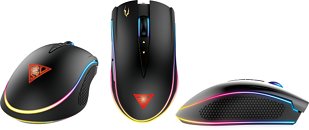Raevenlord
News Editor
- Joined
- Aug 12, 2016
- Messages
- 3,755 (1.18/day)
- Location
- Portugal
| System Name | The Ryzening |
|---|---|
| Processor | AMD Ryzen 9 5900X |
| Motherboard | MSI X570 MAG TOMAHAWK |
| Cooling | Lian Li Galahad 360mm AIO |
| Memory | 32 GB G.Skill Trident Z F4-3733 (4x 8 GB) |
| Video Card(s) | Gigabyte RTX 3070 Ti |
| Storage | Boot: Transcend MTE220S 2TB, Kintson A2000 1TB, Seagate Firewolf Pro 14 TB |
| Display(s) | Acer Nitro VG270UP (1440p 144 Hz IPS) |
| Case | Lian Li O11DX Dynamic White |
| Audio Device(s) | iFi Audio Zen DAC |
| Power Supply | Seasonic Focus+ 750 W |
| Mouse | Cooler Master Masterkeys Lite L |
| Keyboard | Cooler Master Masterkeys Lite L |
| Software | Windows 10 x64 |
Gamdias has recently introduced three new gaming mice with general availability, and an interesting take on the mice product wars: instead of developing different designs and ergonomics for virtually every different mice available in their portfolio, Gamdias seems to be taking an approach more in-line with boutique PC makers and OEM assemblers. They develop a single chassis, and then market several different tiers of products around that same base design.
The Gamdias Zeus P1, M1 and E1, therefore, are based on the same generally ambidextrous design (though the existence of two additional thumb buttons on the left side of the mice does take a little away from a true ambidextrous design), with the Zeus P1 being the top-of-the-line model - with a 12.000 DPI sensor (identical to the one found on the M1, but higher quality than the 7.000 DPI one on the M1) and full RGB lighting (of which the M1 also makes use, while the E1 makes do with "multi-color" lighting).



In addition, the P1's switches are rated for up to 20M clicks, while the M1's are rated for 10M and the E1's at a much lower 8M clicks. The P1 and M1 also share the same polling rate at 1000 Hz, while the E1 sticks with a 125 Hz polling rate. The E1 also sheds HERA software support - which allows the users to program their P1 or M1's buttons, the mice's full RGB lighting as well as save up to five different user profiles.

As for pricing, the Gamdias P1 retails for about $80; the M1 straddles the middle of the product line at $60; and the E1 comes in cheaper at $40.
View at TechPowerUp Main Site
The Gamdias Zeus P1, M1 and E1, therefore, are based on the same generally ambidextrous design (though the existence of two additional thumb buttons on the left side of the mice does take a little away from a true ambidextrous design), with the Zeus P1 being the top-of-the-line model - with a 12.000 DPI sensor (identical to the one found on the M1, but higher quality than the 7.000 DPI one on the M1) and full RGB lighting (of which the M1 also makes use, while the E1 makes do with "multi-color" lighting).



In addition, the P1's switches are rated for up to 20M clicks, while the M1's are rated for 10M and the E1's at a much lower 8M clicks. The P1 and M1 also share the same polling rate at 1000 Hz, while the E1 sticks with a 125 Hz polling rate. The E1 also sheds HERA software support - which allows the users to program their P1 or M1's buttons, the mice's full RGB lighting as well as save up to five different user profiles.

As for pricing, the Gamdias P1 retails for about $80; the M1 straddles the middle of the product line at $60; and the E1 comes in cheaper at $40.
View at TechPowerUp Main Site


